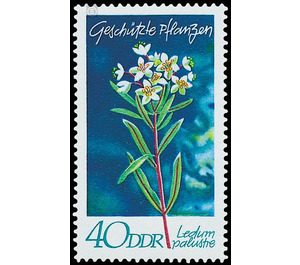Protected native plants - Germany / German Democratic Republic 1970 - 40 Pfennig
Theme: Flora
| Country | Germany / German Democratic Republic |
| Issue Date | 1970 |
| Face Value | 40.00 |
| Color | multi-colored green |
| Perforation | K 14 |
| Printing Type | Photogravure |
| Stamp Type | Postage stamp |
| Item Type | Stamp |
| Chronological Issue Number | 1309 |
| Chronological Chapter | GER-DDR |
| SID | 183131 |
| In 17 Wishlists | |
Protected plants The Ministry of Posts and Telecommunications of the German Democratic Republic publishes six multicolored special postal stamps with images of protected plants. Ledum palustre L. (40 pfennig value) The marsh peat belongs to the heather family (Ericaceae). The shrub with the evergreen, leathery and down-rolled leaves and the strongly fragrant white flowers is a characteristic plant of moorland in the sandy areas of the eastern and northern GDR. Now and then he covers larger areas in the moor-pine forests. In the Elbsandsteingebirge he settles on inaccessible Felssimsen. The stocks of the Porte have declined sharply in recent decades by collectors (moth herb) and Moorkultivierungen - especially west of the Elbe. One expression of the gradual decline of the Nordic continental species is the eastward shift of its western distribution border, which leads through the GDR.


